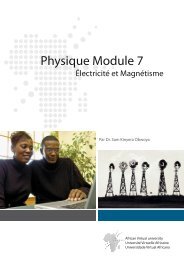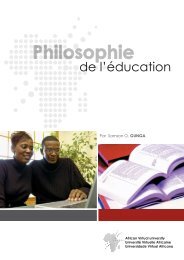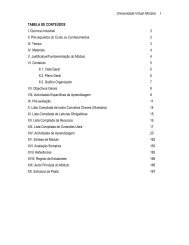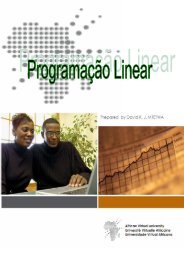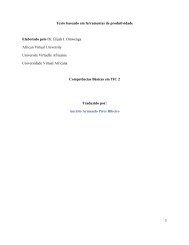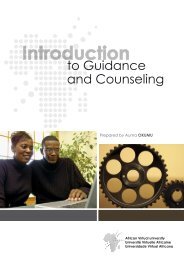Comparative Education.pdf - OER@AVU - African Virtual University
Comparative Education.pdf - OER@AVU - African Virtual University
Comparative Education.pdf - OER@AVU - African Virtual University
You also want an ePaper? Increase the reach of your titles
YUMPU automatically turns print PDFs into web optimized ePapers that Google loves.
<strong>Education</strong> in Sub-Saharan <strong>African</strong> Countries<br />
<strong>African</strong> <strong>Virtual</strong> <strong>University</strong><br />
Historically, <strong>African</strong> educational system is characterized by colonial legacy. Most<br />
countries on the continent pattern their education systems after systems that<br />
were established during the colonial period. In Angola, for instance, secondary<br />
school education is divided into two streams: general education and vocational<br />
education similar to the Portuguese educational system. In addition to colonial<br />
legacy, Africa has some of the poorest countries in the world. In 2001 the Gross<br />
revenue for the continent per person was 671 US Dollars as compared to 34,000<br />
US Dollars per person in the United States of America (Oduaran and Oduaran<br />
2005). Several factors currently constrain educational achievement in Africa including<br />
conflicts, poverty, and diseases. The civil wars in Mozambique and Angola<br />
destroyed the educational systems of the two countries. According to Oduaran<br />
and Oduaran (2005), current strategies for improving educational provision at<br />
university level in <strong>African</strong> countries include: mature-age entry schemes, open and<br />
distance learning, e-learning and accreditation of prior learning.<br />
After independence in the 1960s and 1970s, Sub-Saharan <strong>African</strong> countries<br />
devoted great efforts to develop education. The growth in school enrollments<br />
averaged about 5 percent increase annually (Ndoye 2008). In the 1980s, the<br />
economic crisis that followed the oil crisis led to a relative stagnation in school<br />
enrollment. Although there were marked differences in the efforts focused on<br />
education between countries, with some countries such as Bostwana and Zimbabwe<br />
performing quite well, the overall educational situation in Africa in 1990<br />
was gloomy. According to Ndoye, (2008) on the eve of the Jomtien Conference<br />
in 1990, one <strong>African</strong> child out of four did not have access to primary education<br />
and one <strong>African</strong> adult out of two did not know how to read or write. However,<br />
Sub-Saharan Africa has recorded some positive trends in education as can be<br />
seen in Box # 4.







